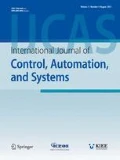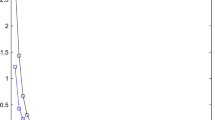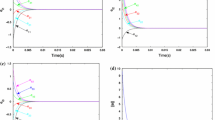Abstract
This paper focuses on the synchronization of reaction-diffusion complex dynamical networks with coupling delay. In order to reflect the uncertainties of the controller, the nonfragile problem is considered. Furthermore, we also take into account the dissipativity analysis problem, which contains the \(\cal{H}_{\infty}\) performance and passivity performance in a unified framework. By utilizing the Lyapunov functional method, two sufficient delay-dependent conditions, which ensure the considered system is globally asymptotically synchronized onto the unforced node and strictly dissipative, are established in terms of linear matrix inequality. Finally, three numerical examples are employed to demonstrate the effectiveness of the design methods.
Similar content being viewed by others
References
G. A. Pagani and M. Aiello, “Power grid complex network evolutions for the smart grid,” Physica A-Statistical Mechanics & Its Applications, vol. 396, no. 2, pp. 248–266, February 2014.
J. Mattes, D. Trystram, and J. Demongeot, “Parallel image processing using neural networks: Applications in contrast enhancement of medical images,” Parallel Processing Letters, vol. 8, no. 1, pp. 63–76, 1998.
P. Liu, Y. Liu, M. Liu, and Y. Xu, “Complex network effects in large multi-robot collaborate information system,” Proc. of International Conference on Industrial Informatics — Computing Technology, Intelligent Technology, Industrial Information Integration (ICIICII), pp. 303–306, December 2016.
M. Nekovee, Y. Moreno, G. Bianconi, and M. Marsili, “Theory of rumour spreading in complex social networks,” Physica A-statistical Mechanics & Its Applications, vol. 374, no. 1, pp. 457–470, January 2007.
R. J. Williams, E. L. Berlow, and J. A. Dunne, “Two degrees of separation in complex food webs,” Proceedings of the National Academy of Sciences of the United States of America, vol. 99, no. 20, pp. 12913–12916, October 2002.
S. H. Strogatz, “Exploring complex networks,” Nature, vol. 410, no. 6825, pp. 268–276, Match 2001.
X. Xu, J. Hu, and F. Liu, “Complex network study of Asian Go players,” Chaos, vol. 17, no. 2, pp. 023–111, June 2007.
J. Zhang and M. Small, “Complex network from pseudoperiodic time series: Topology versus dynamics,” Physical Review Letters, vol. 96, no. 23, pp. 238–701, July 2006.
P. Delellis, M. D. Bernardo, T. E. Gorochowski, and G. Russo, “Synchronization and control of complex networks via contraction, adaptation and evolution,” IEEE Circuits & Systems Magazine, vol. 10, no. 3, pp. 64–82, February 2010.
Y. Xu, W. Zhou, J. Fang, and W. Sun, “Adaptive synchronization of the complex dynamical network with nonderivative and derivative coupling,” Neurocomputing, vol. 374, no. 15–16, pp. 1673–1677, April 2010.
C. Li and G. Chen, “Synchronization in general complex dynamical networks with coupling delays,” Physica A-statistical Mechanics & Its Applications, vol. 343, pp. 263–278, November 2014.
H. Gao, J. Lam, and G. Chen, “New criteria for synchronization stability of general complex dynamical networks with coupling delays,” Physics Letters A, vol. 360, no. 2, pp. 263–273, December 2006.
K. Li, S. Guan, X. Gong, and C. Lai, “Synchronization stability of general complex dynamical networks with time-varying delays,” Physics Letters A, vol. 372, no. 48, pp. 7133–7139, December 2008.
Y. Liang, X. Wang, and J. Eustace, “Adaptive synchronization in complex networks with non-delay and variable delay couplings via pinning control,” Neurocomputing, vol. 123, pp. 292–298, January 2014.
J. Zhou, Z. Wang, Y. Wang, and Q. Kong, “Synchronization in complex dynamical networks with interval time-varying coupling delays,” Nonlinear Dynamics, vol. 72, no. 1–2, pp. 377–388, January 2013.
J. Hu, Z. Wang, G. Liu, and H. Zhang, “Variance-constrained recursive state estimation for time-varying complex networks with quantized measurements and uncertain inner coupling,” IEEE Transactions on Neural Networks and Learning Systems, August 2019.
G. Yang and W. Che, “Non-fragile H∞ filter design for linear continuous-time systems,” Automatica, vol. 44, no. 11, pp. 2849–2856, November 2008.
Y. Liu, B. Guo, J. H. Park, and S. M. Lee, “Nonfragile exponential synchronization of delayed complex dynamical networks with memory sampled-data control,” IEEE Transactions on Neural Networks and Learning Systems, vol. 29, no. 1, pp. 118–128, October 2016.
K. Mathiyalagan, R. Anbuvithya, R. Sakthivel, J. H. Park, and P. Prakash, “Non-fragile H∞ synchronization of memristor-based neural networks using passivity theory,” Neural Networks, vol. 74, pp. 85–100, November 2015.
J. Li, Z. Li, Y. Xu, K. Gu, W. Bao, and X. Xu, “Eventtriggered non-fragile state estimation for discrete nonlinear Markov jump neural networks with sensor failures,” International Journal of Control, Automation and Systems, vol. 17, no. 5, pp. 1131–1140, May 2015.
X. Song, J. Man, Z. Fu, M. Wang, and J. Lu, “Memory-based state estimation of T-S fuzzy Markov jump delayed neural networks with reaction-diffusion terms,” Neural Processing Letters, vol. 50, pp. 2529–2546, April 2019.
X. Song, M. Wang, S. Song, and Z. Wang, “Intermittent pinning synchronization of reaction-diffusion neural networks with multiple spatial diffusion couplings,” Neural Computing and Applications, vol. 31, no. 12, pp. 9279–9294, May 2019.
Y. Jiang and J. Jiang, “Diffusion in social networks: A multiagent perspective,” IEEE Transactions on Systems, Man, and Cybernetics: Systems, vol. 45, no. 2, pp. 198–213, July 2014.
T. Dong, A. Wang, H. Zhu, and X. Liao, “Event-triggered synchronization for reaction-diffusion complex networks via random sampling,” Physica A-Statistical Mechanics & Its Applications, vol. 495, pp. 454–462, April 2018.
N. Ozcan, M. S. Ali, J. Yogambigai, Q. Zhu, and S. Arik, “Robust synchronization of uncertain Markovian jump complex dynamical networks with time-varying delays and reaction-diffusion terms via sampled-data control,” Journal of the Franklin Institute, vol. 355, no. 3, pp. 1192–1216, Februray 2018.
J. C. Willems, “Dissipative dynamical systems part I: General theory,” Archive for Rational Mechanics and Analysis, vol. 45, no. 5, pp. 321–351, January 1972.
J. C. Willems, “Dissipative dynamical systems part II: Linear systems with quadratic supply rates,” Archive for Rational Mechanics and Analysis, vol. 45, no. 5, pp. 352–393, January 1972.
Y. Liu, J. H. Park, B. Guo, F. Fang, and F. Zhou, “Eventtriggered dissipative synchronization for Markovian jump neural networks with general transition probabilities,” International Journal of Robust and Nonlinear Control, vol. 28, no. 13, pp. 3893–3908, May 2018.
X. Wang, X. Zhang, and X. Yang, “Delay-dependent robust dissipative control for singular LPV systems with multiple input delays,” International Journal of Control, Automation and Systems, vol. 17, no. 2, pp. 327–335, January 2019.
H. Shen, T. Wang, J. Cao, G. Lu, Y. Song, and T. Huang, “Nonfragile dissipative synchronization for Markovian memristive neural networks: A gain-scheduled control scheme,” IEEE Transactions on Neural Networks and Learning Systems, vol. 30, no. 6, pp. 1841–1853, June 2019.
L. Su, D. Ye, and X. Yang, “Dissipative-based sampleddata synchronization control for complex dynamical networks with time-varying delay,” Journal of the Franklin Institute, vol. 354, no. 15, pp. 6855–6876, October 2017.
H. D. Choi, C. K. Ahn, P. Shi, L. Wu, and M. T. Lim, “Dynamic output-feedback dissipative control for T-S fuzzy systems with time-varying input delay and output constraints,” IEEE Transactions on Fuzzy Systems, vol. 25, no. 3, pp. 511–526, May 2016.
J. Cheng, J. H. Park, X. Zhao, J. Cao, and W. Qi, “Static output feedback control of switched systems with quantization: a nonhomogeneous sojourn probability approach,” International Journal of Robust and Nonlinear Control, vol. 29, no. 17, pp. 5992–6005, August 2019.
J. H. Park, H. Shen, X. Chang, and T. H. Lee, Recent Advances in Control and Filtering of Dynamic Systems with Constrained Signals, Springer, 2019.
L. Scheeffer, “Ueber die Bedeutung der Begriffe Maximum und Minimum in der Variationsrechnung,” Mathematische Annalen, vol. 26, no. 2, pp. 197–208, June 1886.
P. Park, W. Lee, and S. Lee, “Auxiliary function-based integral inequalities for quadratic functions and their applications to time-delay systems,” Journal of the Franklin Institute, vol. 352, no. 4, pp. 1378–1396, April 2015.
X. Song, J. Man, C. K. Ahn, and S. Song, “Finite-time dissipative synchronization for Markovian jump generalized inertial neural networks with reaction-diffusion terms,” IEEE Transactions on Systems, Man, and Cybernetics: Systems, December 2019.
J. Cheng, J. H. Park, X. Zhao, H. Karimi, and J. Cao, “Quantized nonstationary filtering of network-based Markov switching RSNSs: A multiple hierarchical structure strategy,” IEEE Transactions on Automatic Control, December 2019.
J. Cheng and Y. Zhan, “Nonstationary l2 — l∞ filtering for Markov switching repeated scalar nonlinear systems with randomly occurring nonlinearities,” Applied Mathematics and Computation, vol. 365, no. 15, pp. 124714, January 2020.
Author information
Authors and Affiliations
Corresponding author
Additional information
Publisher’s Note Springer Nature remains neutral with regard to jurisdictional claims in published maps and institutional affiliations.
Recommended by Associate Editor Yingmin Jia under the direction of Editor Fumitoshi Matsuno.
Xiaona Song received her Ph.D. degree in control science and engineering from Nanjing University of Science and Technology, Nanjing, China, in 2011. From Feb. 2009 to Aug. 2009 and Apr. 2016 to Apr. 2017, she was a visiting scholar with the Department of Electrical Engineering, Utah State University and Southern Illinois University Carbondale, respectively. From July 2019 to Aug. 2019, she was a visiting scholar with the Department of Electrical Engineering, Yeungnam University, Republic of Korea. Since 2011, she has been with Henan University of Science and Technology, Luoyang, China, where she is currently a Professor with the School of Information Engineering. Her current research interests include Markov jump distributed parameter systems, complex networks, fractional-order systems and control, fuzzy systems, nonlinear control.
Renzhi Zhang received his B.S. degree in automation from the School of Information Engineering, Xiangtan University, Xiangtan, China in 2018. He is studying for an M.S. degree in the School of Information Engineering, Henan University of Science and Technology, Luoyang, China. His current research interests include complex networks, neural networks, Markov jump distributed parameter systems.
Mi Wang received his B.S. degree in automation from the School of Information Engineering, Henan University of Science and Technology, Luoyang, China in 2018. He is studying for an M.S. degree in the School of Information Engineering, Henan University of Science and Technology, Luoyang, China. His current research interests include Markov jump distributed parameter systems, neural networks, fault tolerant control and filtering.
Junwei Lu received her B.S. degree and M.S. degree from Nanjing University of Aeronautics and Astronautics in 2001, and Nanjing University of Science and Technology in 2008, respectively. Her current research interests include robust filtering and control, time-delay systems and nonlinear systems.
Rights and permissions
About this article
Cite this article
Song, X., Zhang, R., Wang, M. et al. Nonfragile Dissipative Synchronization of Reaction-diffusion Complex Dynamical Networks with Coupling Delays. Int. J. Control Autom. Syst. 19, 1252–1263 (2021). https://doi.org/10.1007/s12555-020-0091-8
Received:
Revised:
Accepted:
Published:
Issue Date:
DOI: https://doi.org/10.1007/s12555-020-0091-8




